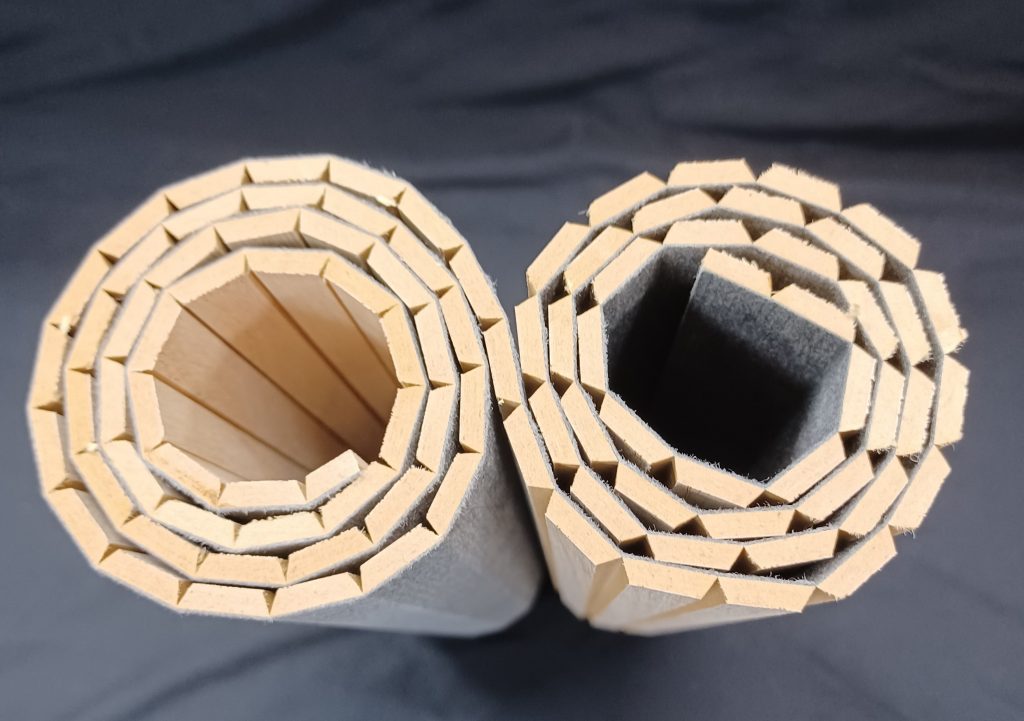2024-09-13
Usar tableros de madera flexibles y enrollables ranurados (tablero tambour) para hacer una puerta tambour
Hoja de especificaciones de paneles de madera flexibles y enrollables (tableros de tambor)
Tablero de panel de pared de palos de madera maciza o MDF semicircular acanalado flexible
Tipos de madera: Roble Rojo Macizo, Tablero MDF
Tamaño: 4 pies x 8 pies (1200 mm x 2400 mm)
Altura: 6 mm
Barra semicircular: Ancho de 18 mm
Soporte: Respaldo de tela no tejida reforzada con resina ECO
Origen: Hecho en Taiwán
Panel de pared con lamas de madera flexibles y parte superior de chapa de madera
Tipos de madera: Roble, Arce, Cerezo y tablero de MDF
Tamaño: 4 pies x 8 pies (1200 mm x 2400 mm)
Espesor: 3 mm
Listón plano con ranura en V: 13 mm, 43 mm, 67 mm y otros anchos para pedidos especiales
Estructura: Capa superior Chapa de madera Capa intermedia Tablero MDF Capa inferior Respaldo de tela no tejida reforzada con resina ECO o papel kraft
Usos: Revestimientos de postes y columnas interiores, panelado de madera para paredes, techos, cubiertas de superficies de muebles, suelos, zócalos, puertas tambour, tableros de madera flexible con ranuras en V, tableros tambour, tableros de MDF, chapa de madera, tableros de madera enrollables, tableros de madera flexibles y enrollables, bricolaje (DIY)
Origen: Hecho en Taiwán
Las mejores tablas tambour: Los tableros tambour y los paneles de madera flexible ranurados en V con una estructura de tres capas—superior en chapa de madera seleccionada, núcleo de MDF y respaldo con soporte textil—son la mejor opción para este material de puertas tambour. Las dos capas superiores se ranuran en V o se acanalan para proporcionar flexibilidad y capacidad de enrollado, con un diseño de listones de madera que garantiza una estética y funcionalidad óptimas.
Los paneles de madera flexibles (paneles Tambour) de tres capas, con la capa superior hecha de chapa de madera seleccionada, la capa intermedia de tablero de MDF y la parte trasera reforzada con textil, están diseñados para ofrecer mayor flexibilidad, capacidad de enrollado y durabilidad, siempre siendo la primera elección para la fabricación de puertas Tambour.
Flexible and rollable wood panel board (Tambour board) making a Tambour door:
Materiales necesarios:
- Panel de madera flexible con ranuras en V (panel Tambour)
- Sistema de riel para puerta Tambour (rodillos y guías)
- Pegamento o adhesivo para madera
- Sierra
- Cinta métrica
- Destornillador
- Papel de lija
- Acabado (pintura, tinte o barniz)
Pasos:
- Medir y cortar: Mide la altura y el ancho de la abertura donde deseas instalar la puerta tambour. Usa una sierra para cortar el tablero de madera flexible ranurado en V (tablero tambour) a las dimensiones requeridas. Asegúrate de que los bordes cortados sean suaves.
- Preparar el sistema de rieles: Instala el sistema de rieles de la puerta tambour siguiendo las instrucciones del fabricante. Esto implicará fijar los rodillos y guías en la parte superior e inferior de la abertura.
- Aplicar adhesivo: Aplica pegamento para madera o adhesivo en la parte trasera del tablero de madera flexible ranurado en V (tablero tambour). Asegúrate de distribuir el adhesivo de manera uniforme.
- Insertar en el riel: Inserta cuidadosamente un extremo en el riel
- Insertar en el riel: Inserta con cuidado el tablero de madera flexible ranurado en V (tablero tambour) en el sistema de rieles en la parte inferior de la abertura. Dobla suavemente el tablero de madera flexible ranurado en V (tablero tambour) y guíalo hacia el riel superior. Desliza lentamente el tablero de madera flexible ranurado en V (tablero tambour) en el riel, asegurándote de que se mueva sin problemas.
- Test and Adjust: Roll the Tambour door up and down a few times to test its movement. Make any necessary adjustments to ensure that the door operates smoothly within the track.
- Recortar si es necesario: Si el tablero de madera flexible ranurado en V (tablero tambour) es un poco más ancho que la abertura, puede ser necesario recortar los lados con una sierra para lograr un ajuste perfecto.
- Acabado: Lija los bordes y superficies de la puerta tambour para lograr un acabado suave. Aplica el acabado de tu elección, como pintura, tinte o barniz, siguiendo las instrucciones del fabricante. Deja secar completamente antes de continuar.
- Instalación final: Una vez que el acabado esté seco, desliza cuidadosamente la puerta tambour de nuevo en el sistema de rieles. Asegúrate de que se mueva libremente y sin dificultad a lo largo del riel.
- Instalación de hardware: Dependiendo del diseño, puede que necesite colocar manijas o perillas en la puerta tambour para facilitar su operación.
- Probar y ajustar nuevamente: Suba y baje la puerta tambour varias veces para asegurarse de que funcione sin problemas. Realice los ajustes finales según sea necesario.
¡Felicidades! Has creado con éxito una puerta tambour utilizando el tablero de madera flexible y enrollable ranurado en V (tablero tambour).
Palabras clave Puerta tambor Tablero de madera flexible ranurado en V, tablero tambour, tablero MDF, chapa de madera, tablero de madera enrollable, tablero de madera flexible y enrollable, DIY
